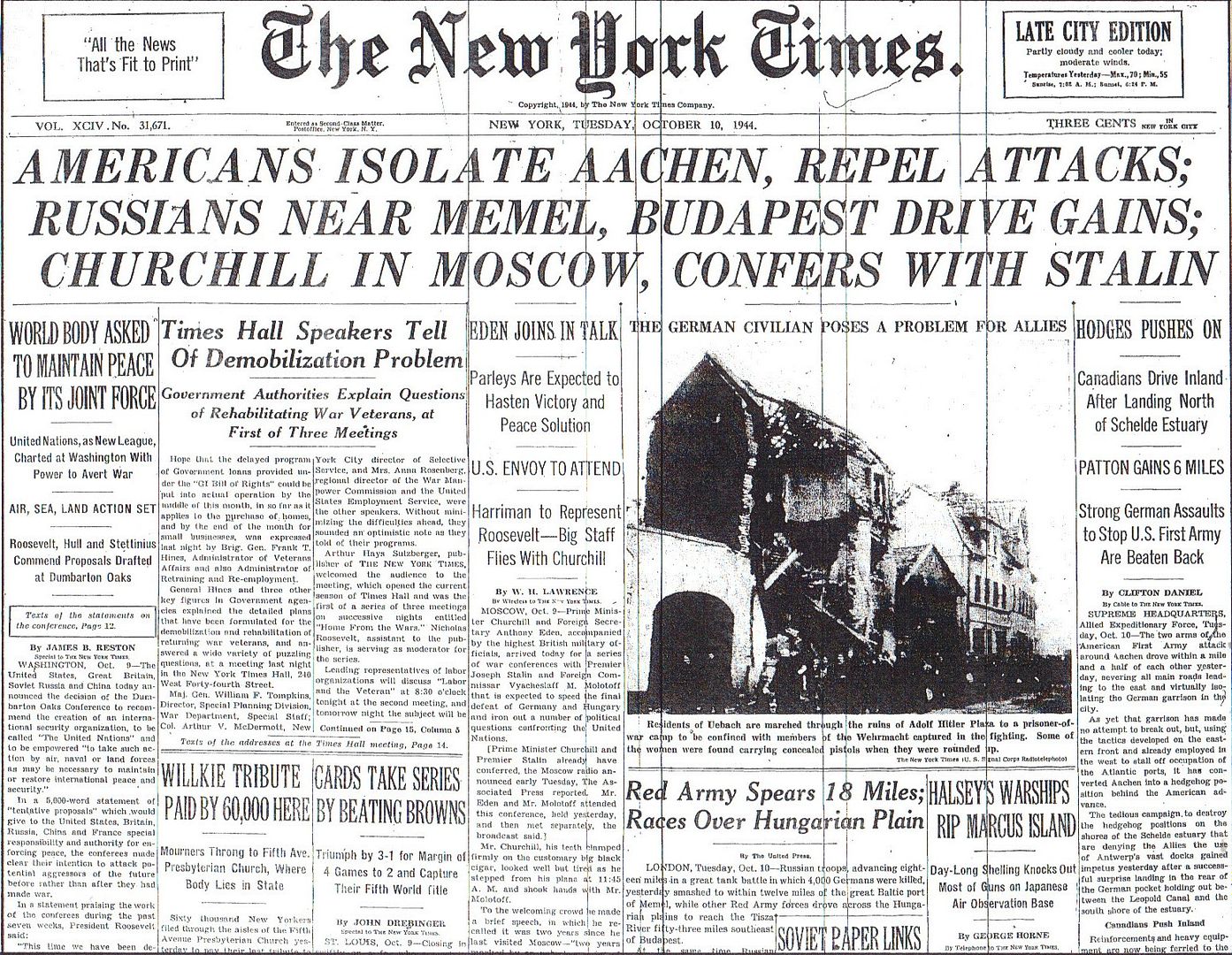
Posted on 10/10/2014 4:14:58 AM PDT by Homer_J_Simpson

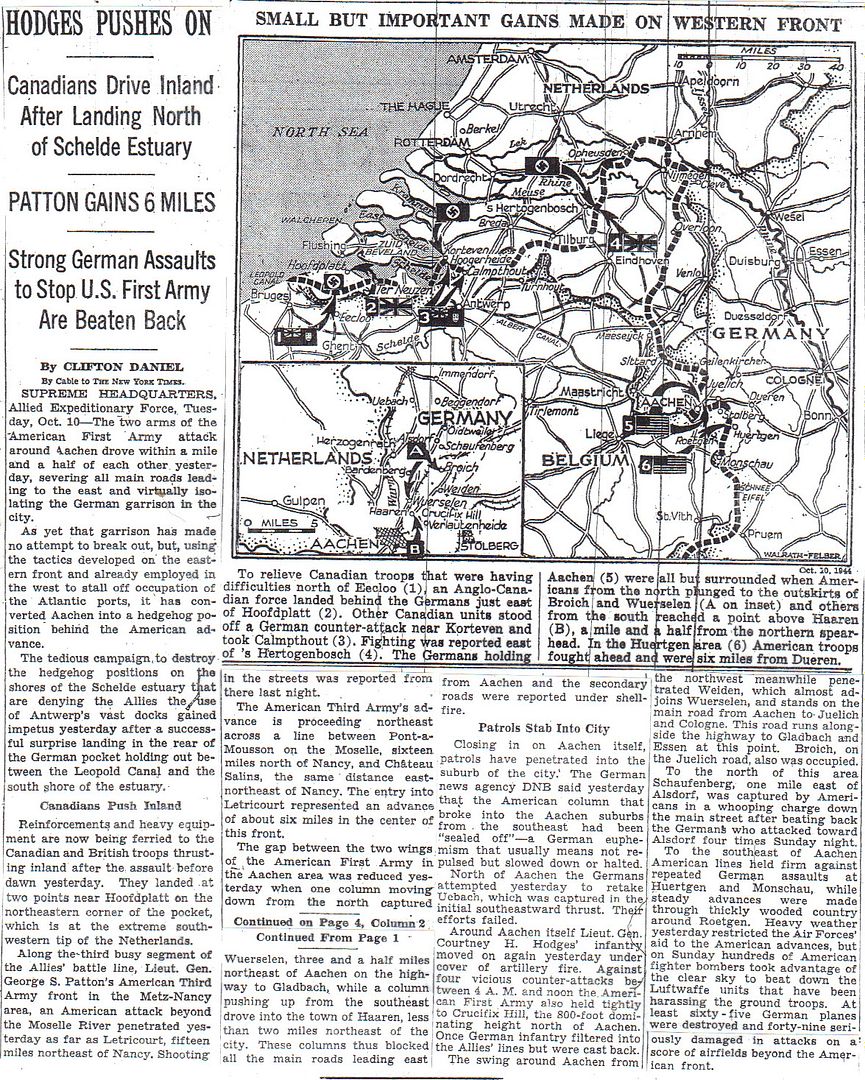
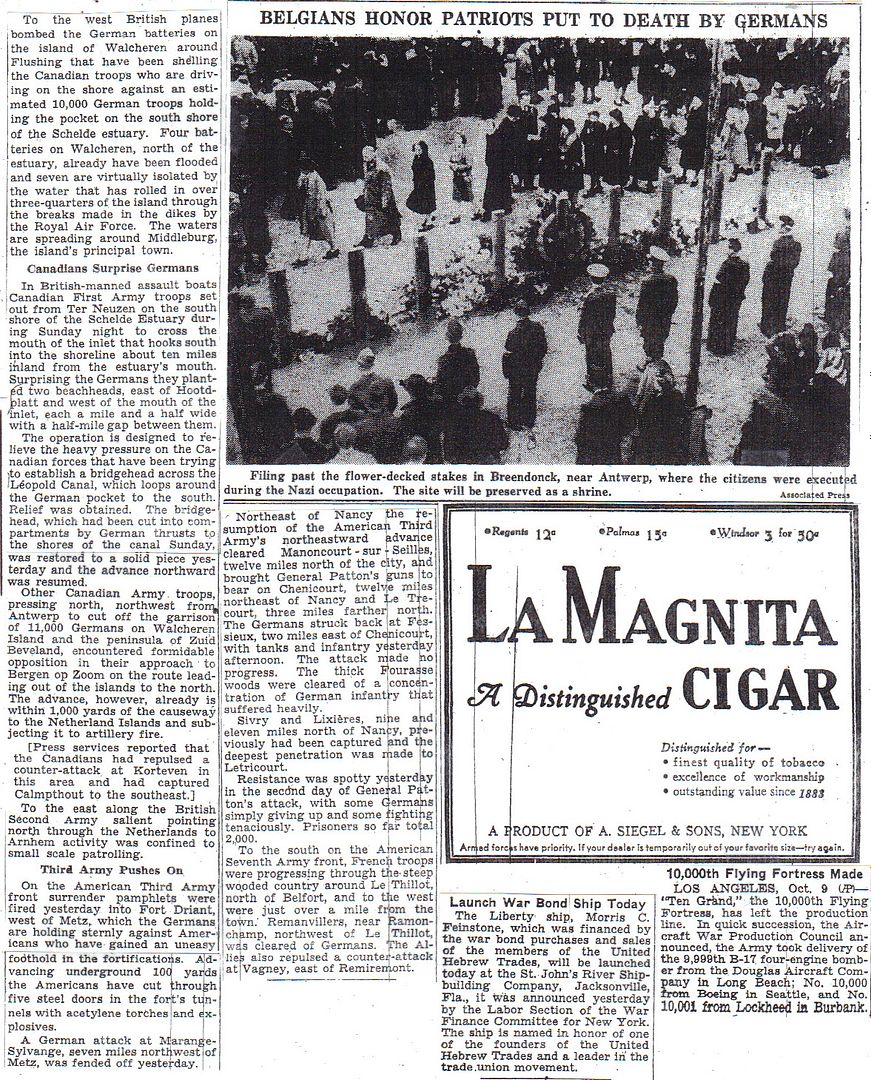
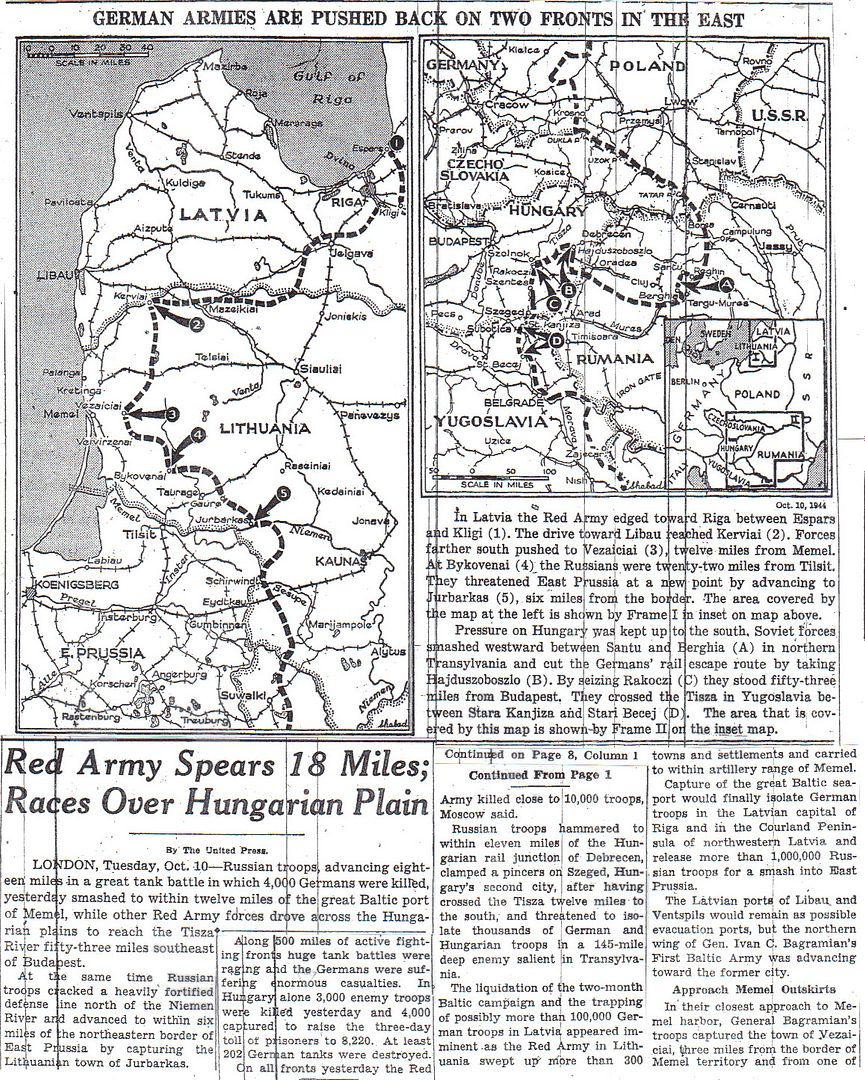
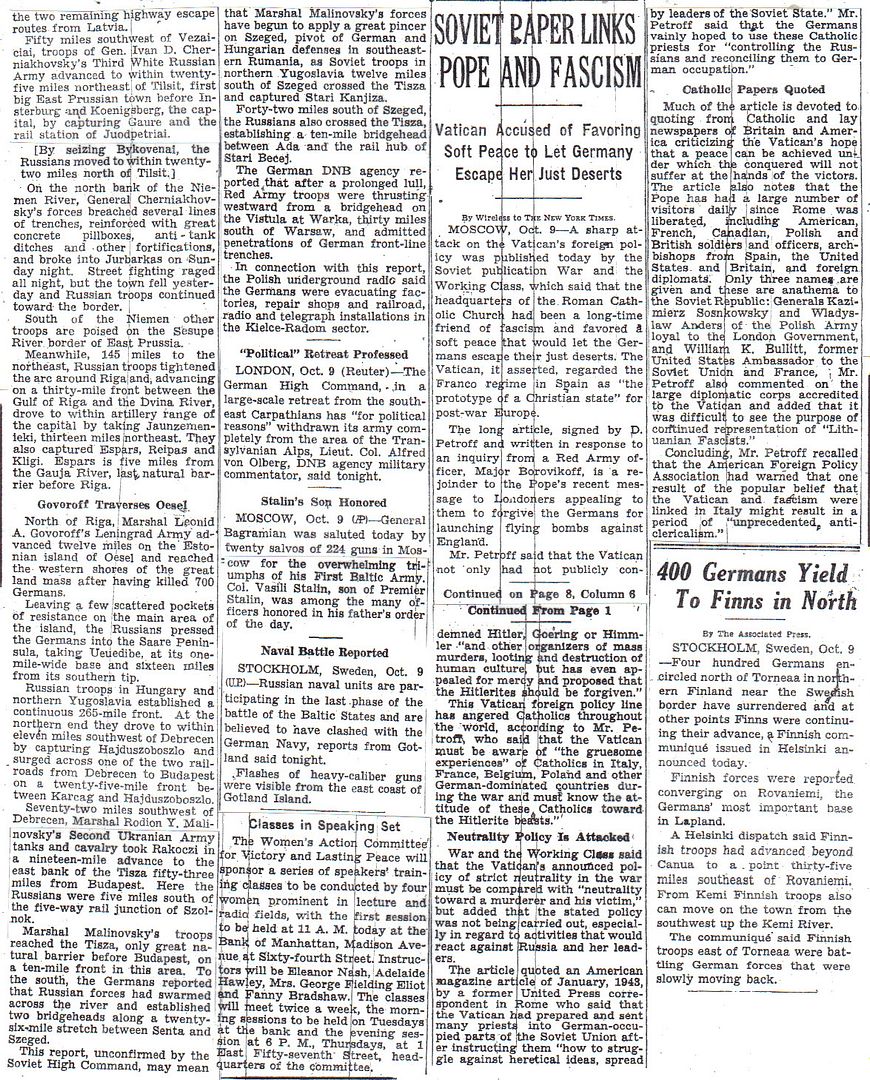

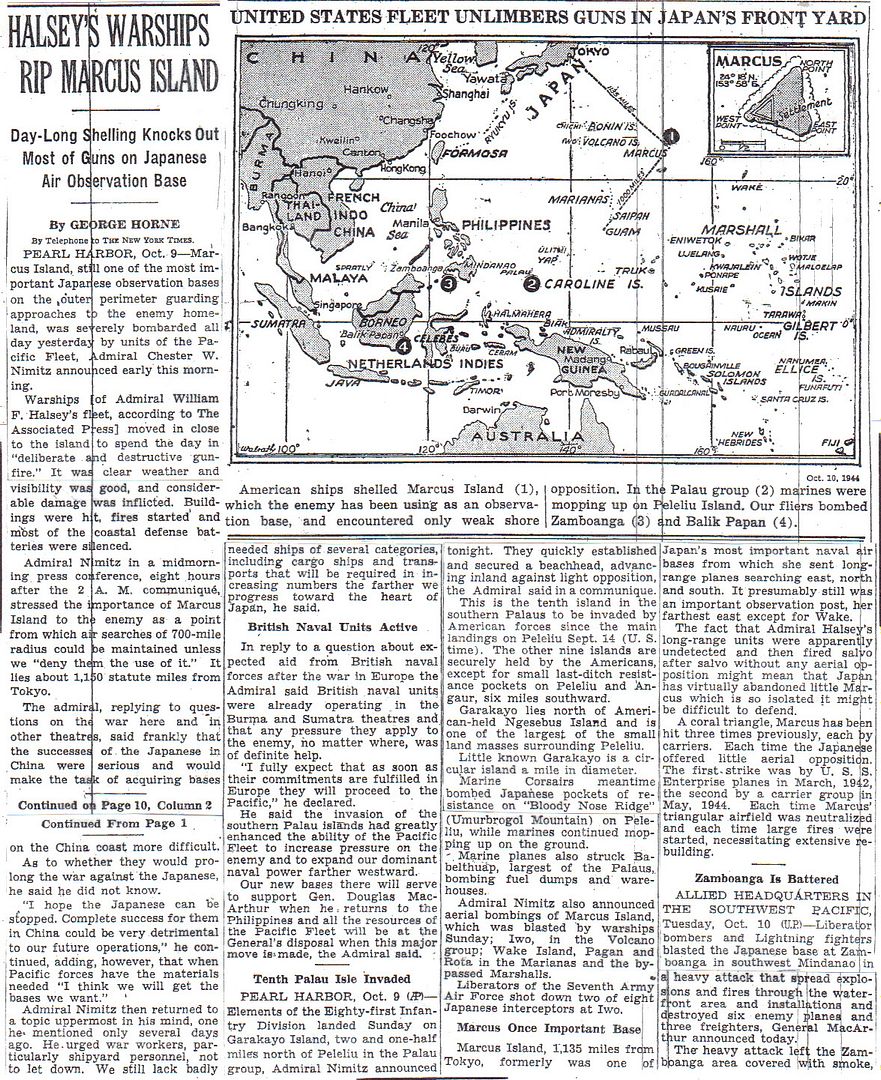

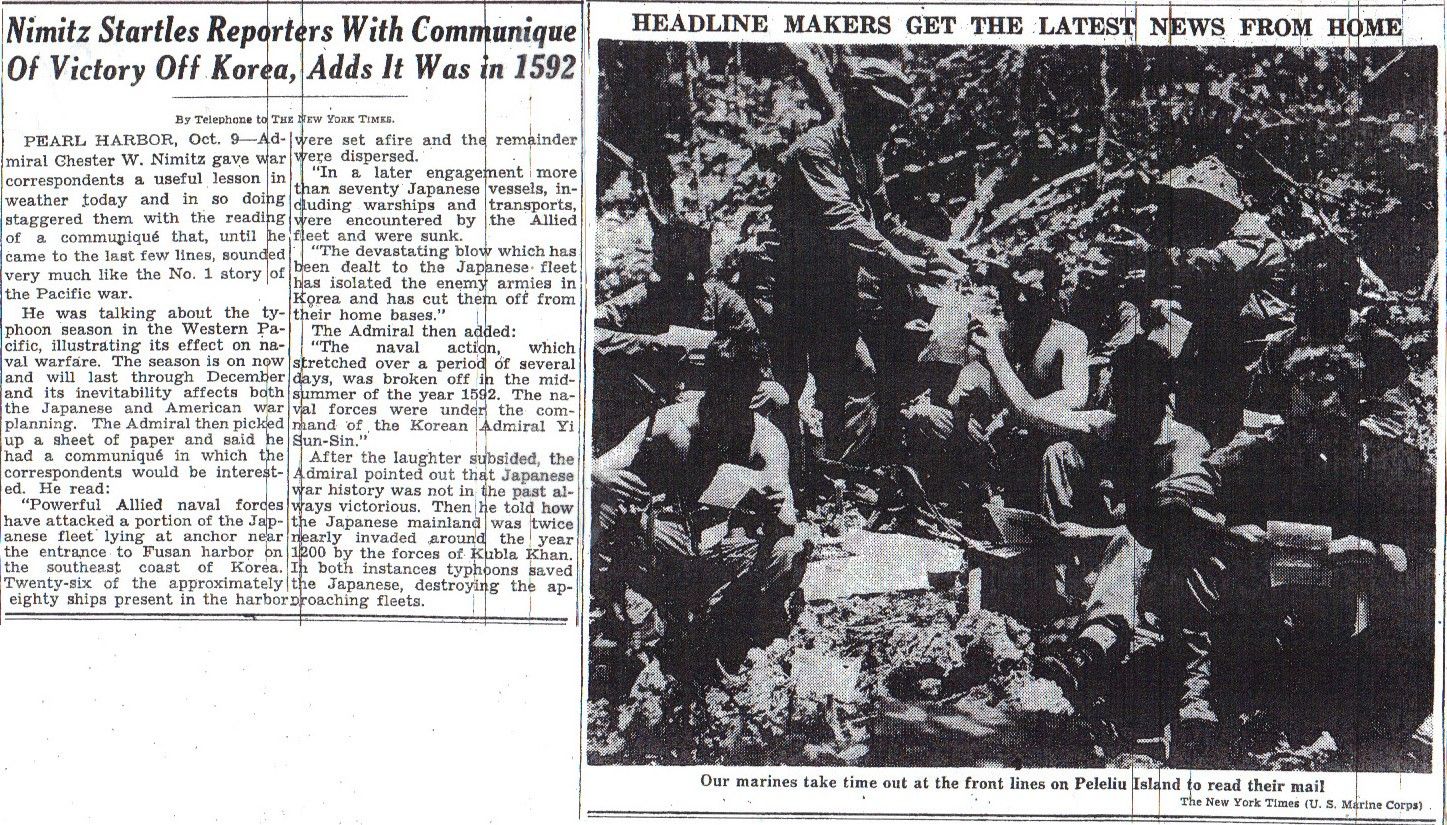
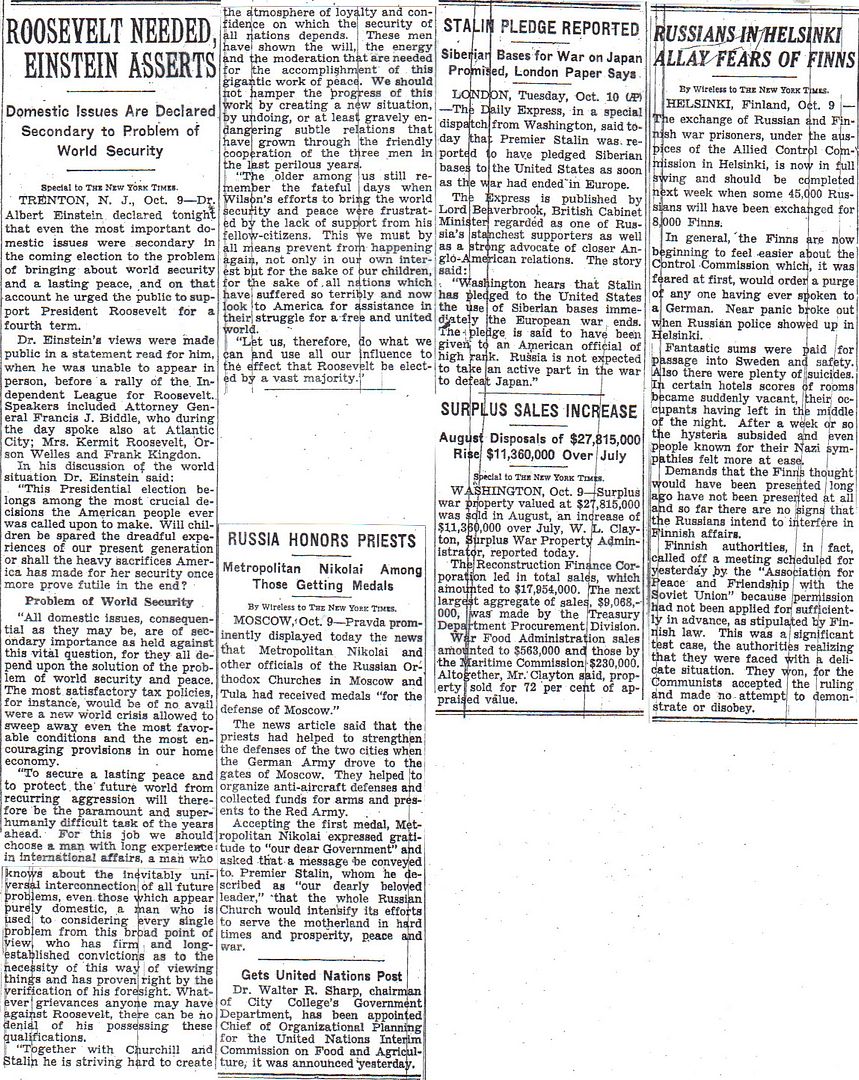
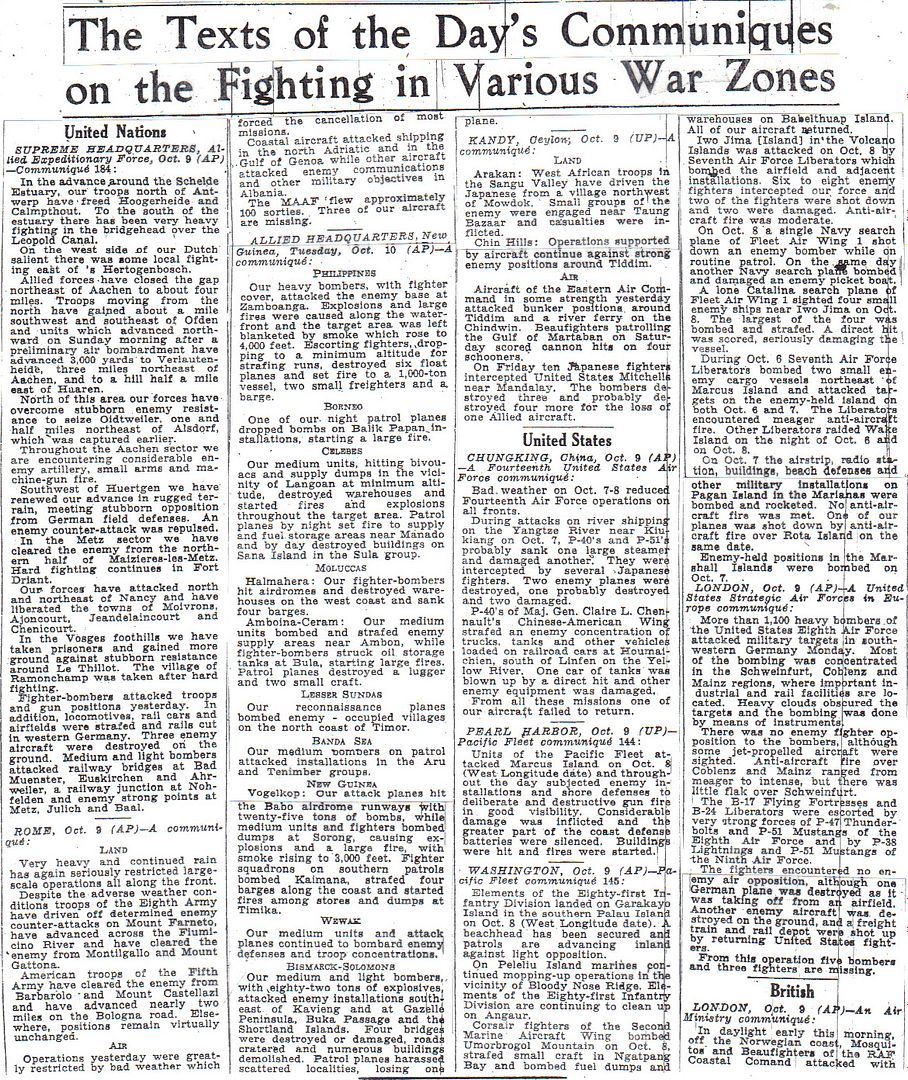
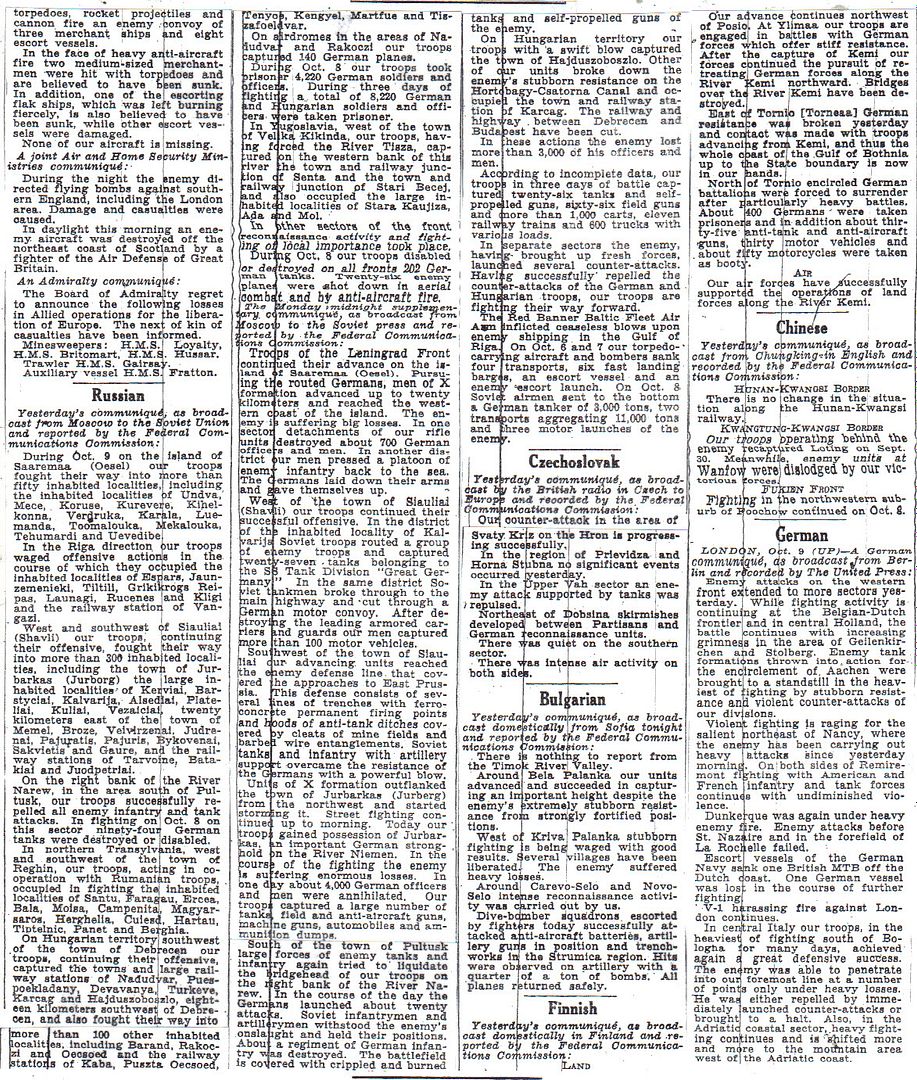
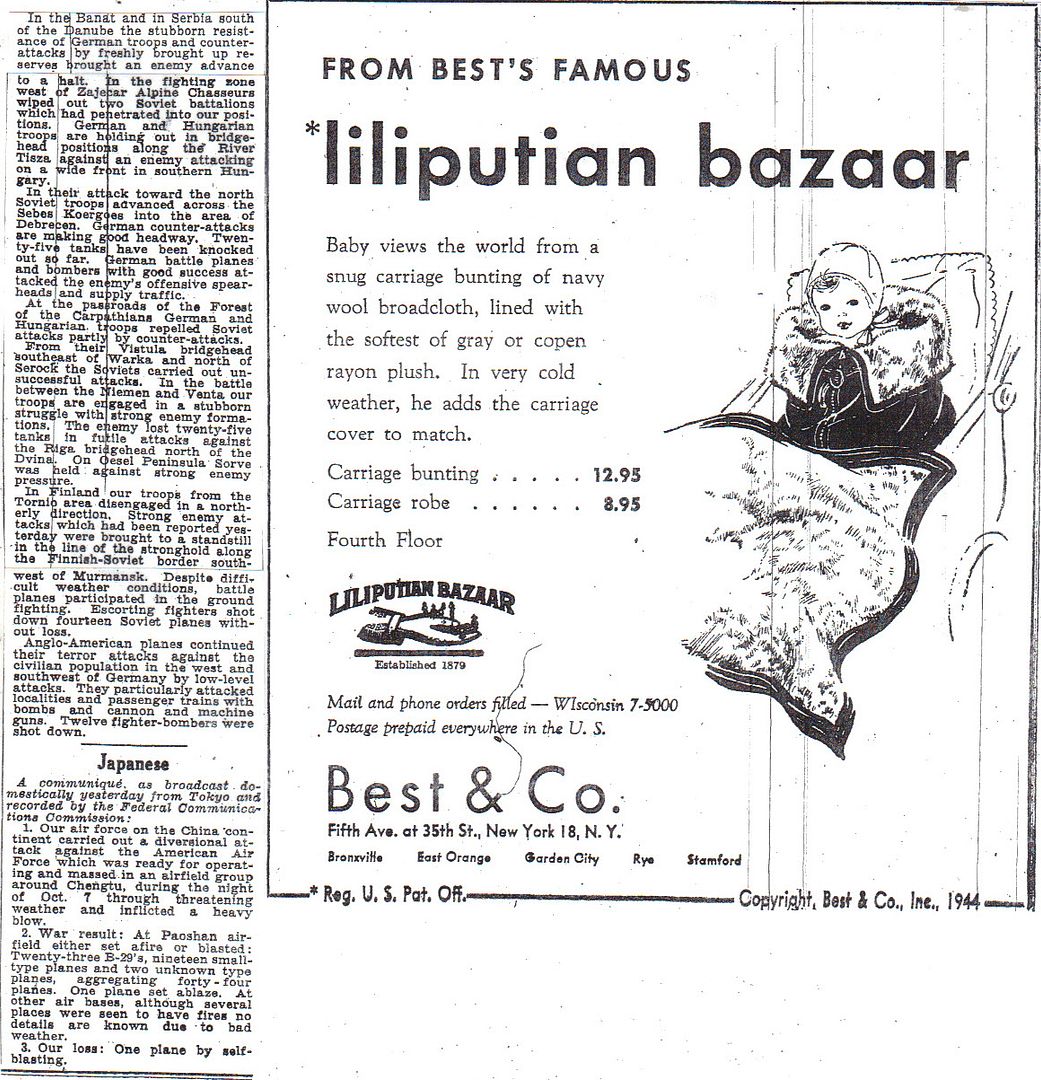
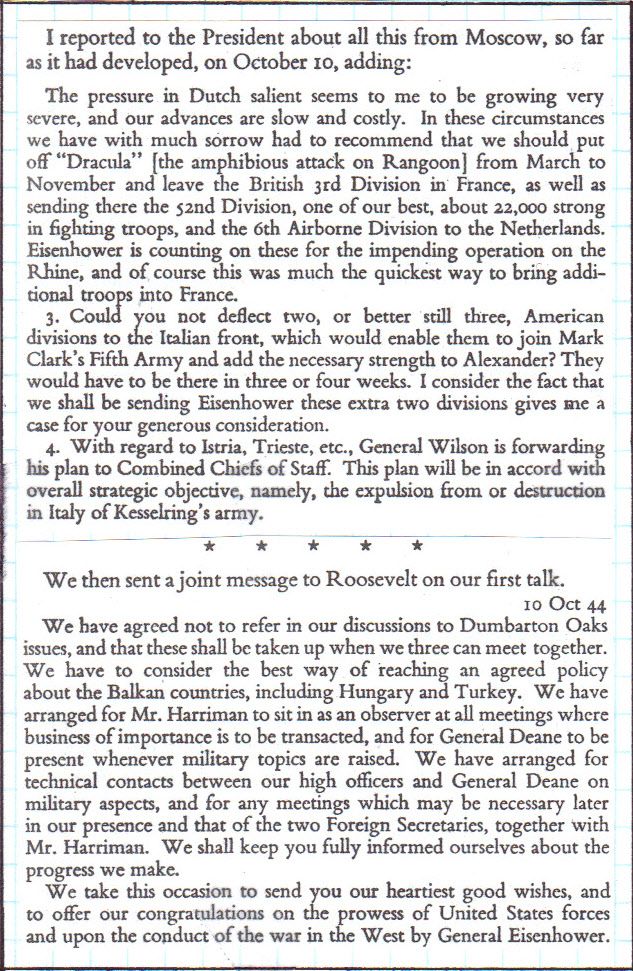
Winston S. Churchill, Triumph and Tragedy
http://www.onwar.com/chrono/1944/oct44/10oct44.htm#
Armored clash in Hungary
Tuesday, October 10, 1944 www.onwar.com
On the Eastern Front... Elements of the Soviet 1st Baltic Front reach the Baltic sea north of Memel. Soviet forces begin attacks on Riga, the capital of Latvia. Meanwhile, in southeast Hungary, there is a large armored engagement near Debrecen. German forces are pushed back but then counterattack and destroy a claimed three corps. In Yugoslavia, the 3rd Ukrainian Front continues attacks south of Belgrade. The Belgrade-Nis rail line is cut near Velika Plana.
In Italy... The US 2nd Corps (part of US 5th Army) continues attacking in the direction of Bologna. Difficult terrain and poor weather assist defending German forces. To the east, British 8th Army forces have crossed the Rubicon River in most areas.
On the Western Front... Allied forces continue ongoing offensives in the Scheldt estuary, around Aachen and Metz. The US 1st Army (part of US 12th Army Group) issues a demand to the German garrison in Aachen to surrender.
In the Ryukyu Islands... US Task Force 38 (Admiral Mitscher), part of the US 3rd Fleet (Admiral Halsey), launches air strikes on Onami-Oshima, Okinawa and Sakashima. TF38 includes 11 fleet carriers, 6 light carriers, 6 battleships and numerous cruisers and destroyers. Many Japanese aircraft are destroyed in combat and 10 merchant ships are sunk around Okinawa. Japanese counter air strikes fail to locate the American ships.
http://www.etherit.co.uk/month/9/10.htm
October 10th, 1944 (TUESDAY)
UNITED KINGDOM: HMS Nabob (ex-USS Edisto), an Attacker-class escort carrier (known in the USN as Bogue-class), Capt. Horatio Nelson Lay OBE RCN CO, was declared a Total Constructive Loss as the result of damage sustained from a torpedo fired by U-354, OLtzS Hans-Jurgen Sthamer, CO, 120 mile west-north-west of North Cape, in the Barents Sea, on 22 Aug 44. Postwar became SS Nabob.
FRANCE: In the U.S. Third Army area’s XII Corps area, the 35th Infantry Division captures Fossieux.
In the French First Army area, the II Corps expands the Moselotte bridgehead to Planois, on the east-west road to La Bresse. Hopes of a quick lateral thrust to secure that communications center are dashed when II Corps is asked to extend northward to the line Fougerolles-Remiremont-Le Tholy-Gerardmer, effective on 14 October, to relieve the southern flank units of U.S. Seventh Army. No further effort is made at this time to extend holdings along north bank of the Moselotte River.
GERMANY: The US 1st Army continues attacks near Aachen. The commander of the US 1st “Big Red One” Infantry Division sends an ultimatum to the German garrison of Aachen: “Surrender or retreat within 24 hours or the city will be blasted to bits.”
In the U.S. First Army’s XIX Corps area, after further efforts to clear Bardenberg, a reserve battalion of the 119th Infantry Regiment, 30th Infantry Division, withdraws at night to permit the shelling of the Germans there; the 120th Infantry Regiment seizes the Birk crossroads, which controls the road to Bardenberg, thus jeopardizing German forces at Bardenberg; the 3oth Infantry Division claims 20 German tanks during fighting yesterday and today. In the VII Corps area, so favorable do the prospects of closing the Aachen gap appear that 1st Infantry Division delivers an ultimatum calling for surrender of the city within 24 hours; the ultimatum states, “Surrender or retreat within 24 hours or the city will be blasted to bits.” In the Huertgen Forest, the Germans overrun the two forward platoons of the 39th Infantry Regiment of 9th Infantry Division in the Wittscheidt area early in day; the 39th Infantry Regiment later recovers lost ground and takes Germeter without opposition; the 60th Infantry Regiment units re-enter the woods and seize a road junction almost 1 mile (1,6 kilometers) southwest of Richelskaul.
During the night of 10/11 October, RAF Bomber Command sends Mosquitos to hit six targets: 47 bomb Cologne, six bomb the marshalling yard (M/Y) at Pforzheim, five each bomb Duisburg and the M/Y at Aschaffenburg, two bomb Lohausen Airfield at Dusseldorf, and one bombs the city of Aschaffenburg .
U-2512 commissioned.
U-2353 laid down.
U-3010 launched.
POLAND: Eight hundred Gypsy children, including more than 100 boys between 9 and 14 years old, are gassed to death at Auschwitz. (John Nicholas and Jack McKillop)
WESTERN EUROPE: Weather cancels daytime bomber and fighter operations by the Ninth Air Force. During the night of 10/11 October, the IX Air defence Command flies patrol over Belgium and western Germany.
NETHERLANDS: 1st Lt. Charles “Chuck” Yeager, 363d FS/357th FG, USAAF, downs five Bf 109s (bringing his total to 6.5) near Assen, Netherlands at about 1100 hours. Yeager ends the war with 11.5 kills. (Skip Guidry)
LITHUANIA: The Soviet First Baltic Front, under General Bagramyan, reaches the Baltic coast of Lithuania on the northern outskirts of Memel and at Palanga, cutting off German forces in the besieged Latvian capital of Riga and the Courland peninsula. Memel, the city which Hitler annexed in March 1939, is holding out as German reinforcements are being rushed northwards, but their aim is primarily defensive: to stop the Russians reaching East Prussia.
Tallinn, the Estonian capital, fell to the Russians on 22 September, just eight days after they opened their current offensive. With Riga apparently doomed and most of Lithuania now under Russian control, the Germans in Courland can only escape by sea. It is thought that as many as 33 divisions of the German Sixteenth and Eighteenth Armies of Army Group North under General Schorner have retreated into Courland with much of their heavy equipment.
BALTIC SEA: While the German navy still controls the Baltic with heavy ships like the ADMIRAL HIPPER, Schorner should be safe, but he is danger of becoming irrelevant as the Russians sweep on to East Prussia.
U-2331 (Type XXIII) Sank near Hela, at approximate position 54.00N, 18.00E, in an accident. 15 dead. Raised and towed to Gotenhafen, further details unknown. (Alex Gordon)
FINLAND: In retaliation for Finland’s ‘base and unhonourable acts’, Generaloberst Lothar Rendulic has ordered that all state owned buildings at Rovaniemi, the largest city of Finnish Lappland, shall be destroyed. This results in almost complete destruction of the center of the city.
Even if the Germans caused widespread destruction in some parts of northern Finland, it has to be stressed that the civilian population (what was left of it after evacuations into Sweden) was spared. After the Finnish invasion of Tornio some hostages were taken, but they were not maltreated and were soon released.
HUNGARY: Budapest: One of the fiercest battles yet seen in this war is raging on the Hungarian plain around the ancient city of Debrecen where two Panzer divisions of Germany’s Army Group South, under the command of General Johannes Friessner, have cut off three of Marshal Rodion Malinovsky’s tank corps advancing from the Ukraine.
German Tiger and Panther tanks are locked in combat with Russian T34s equipped with 85mm guns in a swirling melee. The Germans supported by their Hungarian allies, are inflicting heavy casualties on the Russians who are supported by their new Romanian allies.
Despite his initial success, which has given Hitler new hop that his military fortunes have changed, Friessner knows that he will be unable to maintain his position once the full strength of Malinovsky’s forces is brought to bear.
ITALY: The US II Corps continues the advance towards Bologna. The rugged terrain and weather assist the vigorous German defence.
In the U.S. Fifth Army area, the South African 6th Armoured Division makes another futile attempt to take Mt. Stanco, getting almost to the crest before being driven back. The II Corps opens the third phase of an offensive toward Bologna. The 34th Infantry Division tries in vain to outflank the Monterumici hill mass. In the 91st Infantry Division zone, the 361st Infantry Regiment makes it’s main effort against the Livergnano escarpment without appreciable gains. Efforts to relieve Company K in Livergnano fail; most of the company is captured by the Germans. The 2d Battalion of the 338th Infantry Regiment, 85th Infantry Division attacks lofty Mt. delle Formiche but, although strongly supported by air and artillery, is stopped short of the crest; The 337th, reinforced by the 1st Battalion of the 338th, makes some progress toward Hill 578 of Monterenzio hill mass. In the British XIII Corps area, the Indian 8th Division gains positions near top of Mt. Casalino.
In the British Eighth Army’s V Corps area, German opposition along the Fiumicino River collapses with the capture of Spaccato by the Indian 10th Division. The 46th Division takes Longiano and La Crocetta. The Canadian I Corps regroups for a drive across the Fiumicino River. Reconnaissance elements of the 1st Division cross at Savignano di Romagna without opposition; bridging is begun at the crossing site.
Almost 170 Fifteenth Air Force B-17s and B-24s attack 4 marshalling yards at Treviso and Mestre and bridges at Susegana and San Dona di Piave plus rail lines in surrounding areas; about 90 fighters provide support in the Udine-Treviso area; 350+ other heavy bombers are forced to abort a mission because of weather.
Twelfth Air Force medium bombers are again grounded due to weather; fighter-bombers, though also hampered by weather, manage to closely support ground forces, particularly at Monte delle Formiche where US 85th Infantry Division elements are stopped short of the crest, and attack communications north of the battle area in the Northern Apennines. (Jack McKillop
During the night of 10/11 October, 33 RAF bombers of No. 205 (Heavy Bomber) Group attack the East marshalling yard at Verona.
YUGOSLAVIA: In its advance toward Belgrade, the Red Army breaks through the German lines in Serbia when forces of the Soviet Third Ukrainian Front cut the Nis-Belgrade railroad at Velika Plana. .
GREECE: British and Greek forces capture Corinth.
BURMA: 28 Tenth Air Force P-47 Thunderbolts support ground forces near Pinhe, bomb the towns of Tawbon and Man Naung, and hit targets of opportunity in and near Momauk. Transport operations to various points in the CBI continue at the rate of 250+ sorties.
CHINA: 12 Fourteenth Air Force B-25s bomb and considerably damage the Kunlong ferry; 38 P-40s and P-51s on armed reconnaissance attack a bridge and other targets of opportunity near Mangshih, hit troop areas around Tanchuk and Wuchou, river traffic near Dosing.
FRENCH INDOCHINA: USAAF Fourteenth Air Force fighter-bombers attack locomotives and barges along the northern French Indochina coast.
JAPAN: 4 Eleventh Air Force B-24s abort a strike at Kashiwabara, Paramushiru Island, Kurile Islands, due to strong headwinds. It took the aircraft 5 hours to fly to the location they turn at and 1 hour and 50 minutes to fly back to Shemya Island, Aleutian Islands.
PHILIPPINE ISLANDS: Japanese air units have been reinforced and they have about 400 aircraft in the islands, half of them are considered operational.
NEW GUINEA: 107 Far East Air Forces B-24s escorted by 11 P-38s and 16 P-47s strike the Pendasari oil refinery and an airfield in the Balikpapan area; this is the largest attack of the war on the oil refineries at Balikpapan and the lubricating oil refinery is projected to be out of action for one month. The B-24s and escorting P-47s and P-38s shoot down 18 IJA fighters; 4 B-24s and a P-38 are lost. downed. On Halmahera Island, P-38s and B-25s bomb Djailolo, Kaoe, and Hate Tabako Airfield and the Wasile town area and P-47s hit Liang Airfield on Ambon Island.
In Dutch New Guinea, A-20s hit the Sarmi area and A-20s and B-25s bomb Urarom Airfield. (Robert McFall and Jack McKillop)
PACIFIC OCEAN: US naval TF 38 begins a series of air strikes against Onami-Oshima, Okinawa and Sakashima. Their targets are Japanese aircraft and shipping.
Two USN and a Dutch Navy submarine sink an IJA transport, a merchant transport and a guardboat. The Dutch submarine HNMS Zwaardvisch sinks a Japanese coastal vessel by gunfire about 80 nautical miles (148 kilometers) north of Surabaya, Java, Netherlands East Indies, in position 05.57S, 112.29E.
CAROLINE ISLANDS: On Peleliu Island in the Palau Islands, the 5th Marine Regiment makes limited progress against the Umurbrogol Pocket.
VOLCANO ISLANDS: 14 Seventh Air Force B-24s from Saipan bomb the airfield on Iwo Jima and shipping off the eastern shore.
MARIANA ISLANDS: Twenty four USAAF Seventh Air Force P-47 Thunderbolts attack buildings and storage caves on Pagan Island; later a B-24 bombs the radio station north of the airfield on Pagan Island. Pagan Island is an 18 square mile (46,6 square kilometer) island with active volcanoes in the northern Mariana Islands located about 286 nautical miles (530 kilometers) north-northeast of Guam. The Japanese occupied this German island in 1914 and fortified it and built an airfield on it. The radio station is used to warn Japan when a B-29 Superfortress mission is being flown.
NAURU ISLAND: Twelve USAAF Seventh Air Force B-25 Mitchells from Makin Island bomb runways and adjacent antiaircraft positions on Nauru Island. Nauru Island is a 21 square kilometer (8 square mile) island in the South Pacific Ocean, located about halfway between the Gilbert and Solomon Islands. The island is rich in phosphate deposits and was occupied by the Japanese on 25 August 1942.
WESTERN PACIFIC: The USN’s Task Force 38 (Vice Admiral Marc A. Mitscher) pounds Japanese shipping and installations on Okinawa and other islands in the Ryukyu Islands. This is the first occasion since the Marianas campaign in which all four carrier task groups operate together as one unit and during the day, TF 38 planes fly 1,396 sorties and destroy 4 cargo ships, a submarine tender, 2 midget submarines, 12 PT boats, numerous sampans, various ground installations and shoot down at least 26 aircraft.
The Navy loses 21 aircraft but all but 5 pilots and 4 aircrew are rescued.
One of the F6F Hellcat pilots who achieves ace status today is Lieutenant Bert D. Morris, Jr. of Fighting Squadron Fifteen (VF-15) who shoots down a “Tony” fighter (Kawasaki Ki-61, Army Type 3 Fighter, Hien); Morris appeared in 27 movies between 1936 and 1941 as Wayne Morris and he returned to acting after the war.
This is the beginning of the campaign to retake the Philippines as the vanguard of General MacArthur’s Philippines invasion fleet sails from New Guinea and the nearby Admiralty Islands. TF 38 consists of 9 aircraft carriers and 8 light aircraft carriers as follows:
Task Group 38.1 (TG-38.1) with the aircraft carriers USS Hornet (CV-12) with Carrier Air Group Eleven (CVG-11) and USS Wasp (CV-18) with CVG-14;
and the light aircraft carriers USS Cowpens (CVL-25) with Light Carrier Air Group Twenty Two (CVLG-22) and USS Monterey (CVL-26) with CVLG-28.
TG 38.2 with the aircraft carriers USS Bunker Hill (CV-17) with CVG-8, USS Hancock (CV-19) with CVG-7 and USS Intrepid (CV-11) with CVG-18; and the light aircraft carriers USS Cabot (CVL-28) with CVLG-29 and USS Independence (CVL-22) with Night Light Carrier Air Group Forty One [CVLG(N)-41].
TG 38.3 with the aircraft carriers USS Essex (CV-9) with CVG-15 and USS Lexington (CV-16) with CVG-19; and the light aircraft carriers USS Langley (CVL-27) with CVLG-44 and USS Princeton (CVL-23) with CVLG-27.
TG 38.4 with the aircraft carriers USS Enterprise (CV-6) with CVG-20 and USS Franklin (CV-13) with CVG-13; and the light aircraft carriers USS Belleau Wood (CVL-24) with CVLG-21 and USS Jacinto (CVL-30) with CVLG-51. (John Nicholas and Jack McKillop)
CANADA:
Corvette HMCS Fredericton completed refit Liverpool, Nova Scotia.
ASW target towing vessel assigned to Cornwallis, Nova Scotia.
U.S.A.: Heavy cruiser USS Pittsburgh commissioned.
Destroyer minelayer USS Adams commissioned.
Frigate USS Grand Rapids commissioned.
Destroyer USS Newman K Perry laid down.
http://www.history.army.mil/books/wwii/Siegfried/Siegfried%20Line/siegfried-ch09.htm
On the same day that Field Marshal Montgomery issued this directive, General Eisenhower received a report from the Royal Navy that stirred him to action. The report apparently climaxed an apprehension that had been growing in the Supreme Commander’s mind for several days, a concern that the 21 Army Group could not open the Schelde estuary while at the same time pursuing its other objectives. Unless supplied immediately with adequate ammunition stocks, the report of the Royal Navy indicated, the First Canadian Army would be unable to move to open Antwerp until November.
General Eisenhower promptly placed all stress on clearing the banks of the Schelde. He warned Field Marshal Montgomery that unless Antwerp were opened by the middle of November, Allied operations would come to a standstill. He declared that “of all our operations on our entire front from Switzerland to the Channel, I consider Antwerp of first importance, and I believe that the operations designed to clear up the entrance require your personal attention.”34
Apparently stung by the implication that he was not pushing the attack for Antwerp, the 21 Army Group commander promptly denied the Navy’s “wild statements.” The attack, he said, was already under way and going well. In passing, he reminded the Supreme Commander that the Versailles conference of 22 September had listed the attack on the Ruhr as the main effort of the current phase of operations, and that General Eisenhower only the day before had declared that the first mission of both army groups was gaining the Rhine north of Bonn.
In reply, General Eisenhower explicitly spelled out the priority of Antwerp. “Let me assure you,” he declared in a message of 10 October, “that nothing I may ever say or write with regard to future plans in our advance eastward is meant to indicate any lessening of the need for Antwerp, which I have always held as vital, and which has grown more pressing as we enter the bad weather period.”36 Three days later, after Field Marshal Montgomery again had suggested changes in the command arrangement so that he might have greater flexibility in his operations, General Eisenhower acted to remove any doubts on both Antwerp and command. He declared that the question was not one of command but of taking Antwerp. He did not know the exact state of the Field Marshal’s forces, he said, but he knew they were rich in supplies as compared with US and French units. Because of logistical shortages, the need to put Antwerp quickly in workable condition was pressing. Field Marshal Sir Alan Brooke and General Marshall, British and US Army chiefs, had emphasized on a recent visit to SHAEF that they shared this view. Despite the desire to open Antwerp, General Eisenhower said, he had approved MARKET-GARDEN. All recent experience, however, had pointed to the great need for opening of the Schelde estuary, and he was willing, “as always,” to give additional US troops and supplies to make that possible.
General Eisenhower added that the operation could involve no question of command, “Since everything that can be brought in to help, no matter of what nationality, belongs to you.” Then he dealt at length with the subject of command. If, after receiving these views, Field Marshal Montgomery still classed them as “unsatisfactory,” an issue would exist which would have to be settled by “higher authority.”37
Even before this message reached the 21 Army Group commander, he apparently had concluded that the First US Army could not reach the Rhine and thus that no reason existed for British forces to move alone toward the Ruhr. With the assertion that the Antwerp operations were to assume “complete priority . . ., without any qualification whatsoever,” he had already dispatched “the whole of the available offensive power” of the Second British Army to help the Canadians speed the opening of the port.
LOL!
*mark*
The map seems to bear out the Royal Navy’s concerns about clearing the Scheldt. German 64th Infantry is not budging on the south bank of the Scheldt in the “Breskens Pocket.” In fact, despite the need to open Antwerp, there has been no progress here for several weeks.
The Canadians were trying. They had to root the Germans out one at a time. Several significant batteries on Walcheren Island were a problem, and the Royal Navy was brought in to deal with them.
http://en.wikipedia.org/wiki/Operation_Infatuate
Wow, look at that big red salient!
St. Vith, Malmedy, Bastogne ... why do those names ring a bell?
Disclaimer: Opinions posted on Free Republic are those of the individual posters and do not necessarily represent the opinion of Free Republic or its management. All materials posted herein are protected by copyright law and the exemption for fair use of copyrighted works.